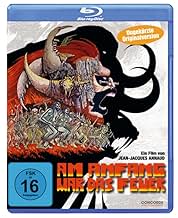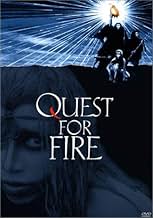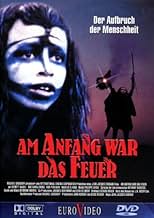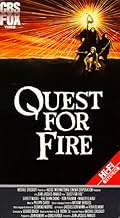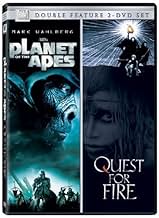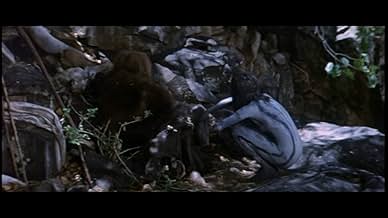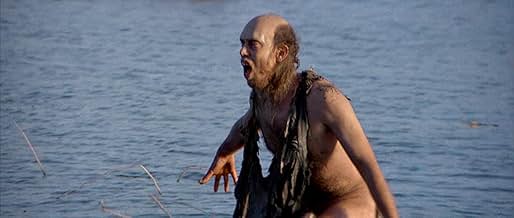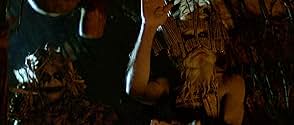AVALIAÇÃO DA IMDb
7,3/10
26 mil
SUA AVALIAÇÃO
Situado na pré-história, quando três membros de uma tribo procuram uma nova fonte de fogo.Situado na pré-história, quando três membros de uma tribo procuram uma nova fonte de fogo.Situado na pré-história, quando três membros de uma tribo procuram uma nova fonte de fogo.
- Direção
- Roteiristas
- Artistas
- Ganhou 1 Oscar
- 11 vitórias e 8 indicações no total
Nicholas Kadi
- Gaw
- (as Nameer El-Kadi)
Franck-Olivier Bonnet
- Aghoo - The Ulam Tribe
- (as Frank Olivier Bonnet)
Joy Boushel
- The Ulam Tribe
- (as Joy Boushell)
- Direção
- Roteiristas
- Elenco e equipe completos
- Produção, bilheteria e muito mais no IMDbPro
Avaliações em destaque
"Quest for Fire" (1981 - 100 minutes), under Jean-Jacques Annaud direction and written by Gérard Brach, was based on the book of J. H. Rosny. The movie develops a travel in time showing one of the biggest conquest of human kind: the domain of fire. It's a 80 thousand years ago beautiful drama. The Ulan tribe lives nearby a natural source of fire. When the fire went out, three members of the tribe have to search for a new flame. After several days of walking and having to face many dangerous situations like wild animals, down temperatures and even cannibal tribes, they found the Ivakas, a more evolved human group that had already discovered how to "make" fire. With locations in Kenya, Scotland, Island and Canada, the movie was based on scientific knowledge, showing convincing habitats and characters. The preparation work of the actors body language was done by the Anthropologist Desmond Morris and Anthony Burgess took care of the "talking" of these human ancestors. Almost an Anthropology documentary, this excellent movie shows at the end a scene that suggests the "discovery of love" between male and female. Absolutely unforgettable.
Stanley Kubrick's classic "2001" celebrates the first weapon, when a hairy primate through some burst of savage genius turns a useless thigh-bone into a dominating club. He thereby takes a giant first step in humanity's long pursuit of bigger and better weapons. On the other hand, "Quest for Fire" dramatizes humanity's other side: the civilizing arrival of the campfire. But not just any campfire; instead it's the security found in mastering the technique to make fire any time the tribe wants. As a result, the Cro-Magnons have for the first time some control over their environment and can take time to relax. That's made apparent at film's end when the clan gathers happily around crackling embers to relate stories through crude gestures and grunts. Perhaps the evolution of complex linguistic forms had its origins in just such relaxed moments, when imagination and thinking could take hold and get expression in the company of others.
There's also that overlooked moment when Naoh humbly approaches the lordly herd of marauding mastodons. Tufts of grass in hand, he bows his head in an unmistakable gesture of submission, to which the herd responds-- not very plausibly --by chasing away the attacking cannibal clan. The point here is that Naoh understands in that quiet moment that we must live humbly with those forces much greater than ourselves if we want to survive-- a possible seed of what would later become religious belief, whether in the forces of nature or in the supposed power of the supernatural.
Of course, this is all speculation. The filmmakers don't exactly hit you over the head with their messages. However, the point is that the film succeeds admirably in getting you to think about the natural history of what these lowly but momentous origins must have been like. Moreover, there are other suggestive moments, such as when the camera transitions from Rae Dawn Chong's pregnant belly to the distant full moon and humanity's far-off future. Some reviewers point out scientific flaws in the script and reject the film on that basis. But that misses the point. Of course the film is not a documentary, so no serious researcher would base a study on it. Nonetheless, the movie remains just that, a well-staged and provocative ninety minutes of unusual filmmaking. I've seen nothing like it before or since.
There's also that overlooked moment when Naoh humbly approaches the lordly herd of marauding mastodons. Tufts of grass in hand, he bows his head in an unmistakable gesture of submission, to which the herd responds-- not very plausibly --by chasing away the attacking cannibal clan. The point here is that Naoh understands in that quiet moment that we must live humbly with those forces much greater than ourselves if we want to survive-- a possible seed of what would later become religious belief, whether in the forces of nature or in the supposed power of the supernatural.
Of course, this is all speculation. The filmmakers don't exactly hit you over the head with their messages. However, the point is that the film succeeds admirably in getting you to think about the natural history of what these lowly but momentous origins must have been like. Moreover, there are other suggestive moments, such as when the camera transitions from Rae Dawn Chong's pregnant belly to the distant full moon and humanity's far-off future. Some reviewers point out scientific flaws in the script and reject the film on that basis. But that misses the point. Of course the film is not a documentary, so no serious researcher would base a study on it. Nonetheless, the movie remains just that, a well-staged and provocative ninety minutes of unusual filmmaking. I've seen nothing like it before or since.
Many of my friends laugh at me when I mention this movie. I don't know what makes so many of them hate it so.. Perhaps the lack of understandable dialogue? Too much like thinking to understand what is going on? Whatever it is, I am one of the few I know who feel this is a very underrated movie.. I know it is not accurate from a scientific perspective... The time line is all messed up.. but so what? I sat there in the theater just thinking.. "suppose live in our distant past WAS something like this movie. Fire=Life=Fire. Along comes a superior tribe and I realize that I could summon the flames at MY WILL. How powerful I would feel.. Almost G-d like! The photography is lush and there is a tinge of humor when the backward tribe learns to laugh. I enjoyed the story and the acting... everything. Rent it! See it twice if you must. Just maybe... we ARE looking back at ourselves.
I saw this film (on VHS rental) so long ago I might have been in it. My (ex) wife & friends thought it was stupid - "What's going on? Nobody's saying anything". I found it mesmerising and have been looking for it ever since (car boot sales, Ebay etc).
OK, if you've two adjacent brain cells, you'll spot the anachronisms and the cheap effects, but credit where it's due for originality and balls - to the director and the backers.
If you're sick of hype and tripe, find it. If you're hooked intravenously to Hollywood pap (as 99.999% of the world's population seem to be) then give it a miss.
Just my 2p.
OK, if you've two adjacent brain cells, you'll spot the anachronisms and the cheap effects, but credit where it's due for originality and balls - to the director and the backers.
If you're sick of hype and tripe, find it. If you're hooked intravenously to Hollywood pap (as 99.999% of the world's population seem to be) then give it a miss.
Just my 2p.
Raw and at times brutal, this story follows three primitive warriors who make a cross-country journey in search of that most precious of natural elements ... fire. In prehistoric times, having fire meant survival from the cold and protection from predators.
In this film, facial gestures, hand movements, general body language and mannerisms of the characters are all consistent with conclusions about early man, as a result of thorough anthropological research. In lieu of modern language the film's dialogue consists of some 350 invented words and sounds, also based on research. In addition, an important part of the film is attention to detail in costumes and makeup, for which the film won several awards. All of these technical cinematic elements combine to create a reasonably accurate visual and audio impression of mankind as it existed some 80,000 years ago.
As you would expect, the film is shot entirely in rugged, remote locations, resulting in landscapes that are stunningly beautiful. Background music is generally low-key and ethereal, like what you might hear in a sci-fi film. There's lots of flute sounds, which reinforce the simplicity of the time period.
For all its technical achievements, this film's main weakness may be the screenplay. When you take away the artifacts of modern life, you're very limited in the kind of story you can tell. And that clearly is the case here, with a plot that drones on with a monotony and repetition that can be tedious, and at times difficult for some viewers.
Although the story's entertainment value may be marginal, "Quest For Fire", with its low tech cinematic style, is interesting not only for its technical elements but also for its over arching theme of modern human's continuity with prehistoric man, based on the element of fire.
In this film, facial gestures, hand movements, general body language and mannerisms of the characters are all consistent with conclusions about early man, as a result of thorough anthropological research. In lieu of modern language the film's dialogue consists of some 350 invented words and sounds, also based on research. In addition, an important part of the film is attention to detail in costumes and makeup, for which the film won several awards. All of these technical cinematic elements combine to create a reasonably accurate visual and audio impression of mankind as it existed some 80,000 years ago.
As you would expect, the film is shot entirely in rugged, remote locations, resulting in landscapes that are stunningly beautiful. Background music is generally low-key and ethereal, like what you might hear in a sci-fi film. There's lots of flute sounds, which reinforce the simplicity of the time period.
For all its technical achievements, this film's main weakness may be the screenplay. When you take away the artifacts of modern life, you're very limited in the kind of story you can tell. And that clearly is the case here, with a plot that drones on with a monotony and repetition that can be tedious, and at times difficult for some viewers.
Although the story's entertainment value may be marginal, "Quest For Fire", with its low tech cinematic style, is interesting not only for its technical elements but also for its over arching theme of modern human's continuity with prehistoric man, based on the element of fire.
Você sabia?
- CuriosidadesBoth Ron Perlman and Everett McGill suffered frostbite; luckily they were able to heal completely. Despite the working conditions, they both enjoyed making the film.
- Erros de gravaçãoThe movie is set 80,000 years ago, and appears to show the one tribe has made pottery. Fragments of ancient pottery found in southern China date back to only 20,000 years, making them the world's oldest known pottery. However, the vessel shown is actually a dried hollow gourd.
- Citações
[first lines]
Title Card: 80,000 years ago, man's survival in a vast uncharted land depended on the possession of fire. / For those early humans, fire was an object of great mystery, since no one had mastered its creation. Fire had to be stolen from nature, it had to be kept alive - sheltered from wind and rain, guarded from rival tribes. / Fire was a symbol of power and a means of survival. The tribe who possessed fire, possessed life.
- Versões alternativasAll UK versions are cut by 8 secs and are missing a shot of a wolf on fire.
- ConexõesFeatured in À propos de 'La guerre du feu' (1981)
Principais escolhas
Faça login para avaliar e ver a lista de recomendações personalizadas
- How long is Quest for Fire?Fornecido pela Alexa
Detalhes
- Data de lançamento
- Países de origem
- Idiomas
- Também conhecido como
- La guerra del fuego
- Locações de filme
- Empresas de produção
- Consulte mais créditos da empresa na IMDbPro
Bilheteria
- Orçamento
- US$ 12.500.000 (estimativa)
- Faturamento bruto nos EUA e Canadá
- US$ 20.959.585
- Faturamento bruto mundial
- US$ 20.962.615
- Tempo de duração
- 1 h 40 min(100 min)
- Cor
- Proporção
- 2.35 : 1
Contribua para esta página
Sugerir uma alteração ou adicionar conteúdo ausente


![Bande-annonce [OV]](https://m.media-amazon.com/images/M/MV5BZTg3YWU0MTMtMDk1Mi00M2Y4LWFiODgtYzFhOTAyMWRjYWY2XkEyXkFqcGdeQXRyYW5zY29kZS13b3JrZmxvdw@@._V1_QL75_UY281_CR74)
